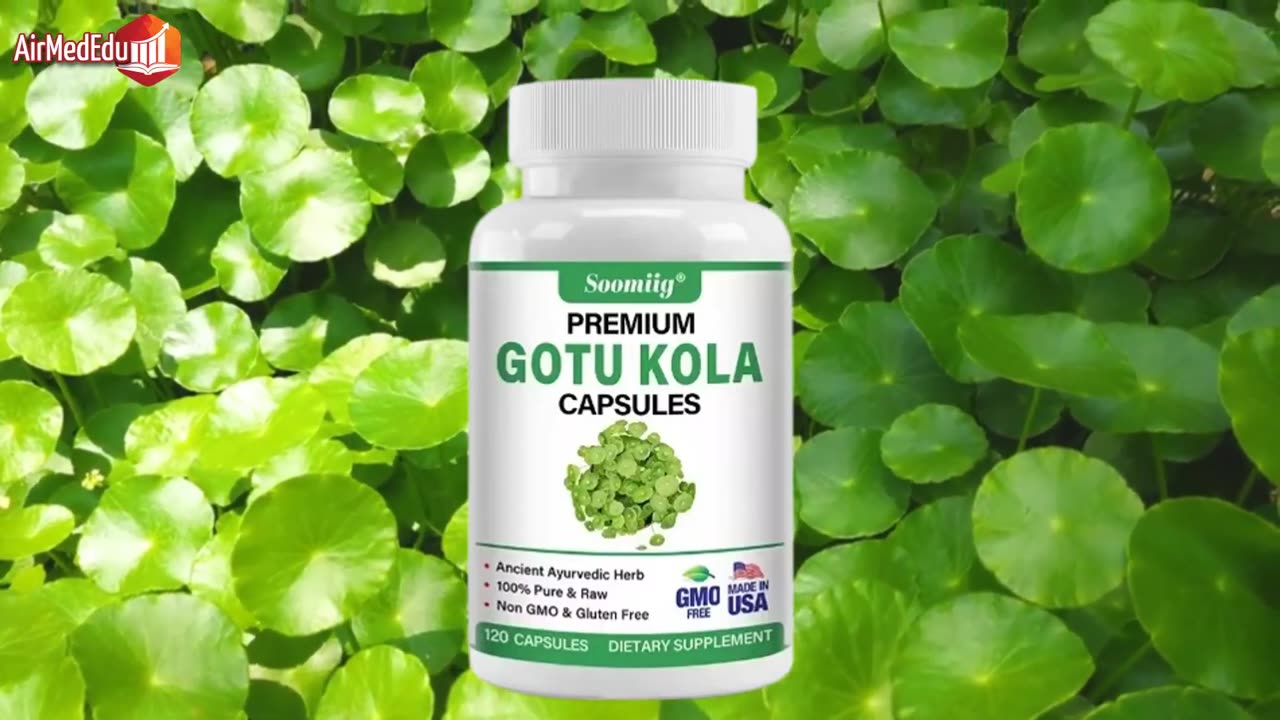Premium Only Content

Gotu Kola, Effects and Benefits, Dosage, Side Effects
Gotu kola, scientifically known as Centella asiatica, is a perennial herb that thrives in humid, tropical climates in Asia, Africa, and parts of the Americas. This plant, which belongs to the Apiaceae family, has been a mainstay of traditional medicine for millennia, particularly in systems such as Indian Ayurveda and Chinese medicine, where it is valued for its ability to promote longevity and restore balance to the body. Its rounded, green leaves, which grow close to the ground in a vine-like shape, contain a wealth of bioactive compounds that make it a versatile remedy.
Historically, it has been used to treat everything from skin wounds to mental disorders, and in ancient cultures, it was considered an "elixir of life" capable of rejuvenating the mind and body. Today, modern science has begun to validate some of these traditional uses, although not all have conclusive evidence, which encourages a cautious approach to its consumption.
Upon entering the body, Gotu Kola displays a series of effects derived primarily from its active components, such as the triterpenoid saponins—including asiaticoside, madecassoside, and asiatic acid—along with flavonoids, tannins, and plant sterols. These compounds act synergistically to modulate key biological processes. For example, they promote collagen synthesis by inhibiting collagen-degrading enzymes, such as matrix metalloproteinases, which strengthens connective tissues and accelerates cell repair. In the circulatory system, they reduce capillary permeability and improve blood flow, decreasing inflammation and edema in weakened veins. At the neurological level, they stimulate the release of brain-derived neurotrophic factors, which promote dendritic growth of neurons and protect against oxidative stress, potentially improving brain plasticity and reducing neuroinflammation. In addition, they exhibit antioxidant properties by neutralizing free radicals, which contributes to the protection of organs such as the liver and kidneys from toxins. In the immune system, they increase the secretion of interleukin-1 beta (IL-1β) from macrophages, which amplifies anti-inflammatory responses without generating excessive inflammation. These mechanisms not only explain its revitalizing action but also underscore its potential to intervene in chronic processes, although the effects vary depending on the method of administration—oral, topical, or in standardized extracts—and the duration of use.
One of Gotu Kola's most notable effects on the body is its ability to improve blood circulation, particularly in cases of chronic venous insufficiency, where leg veins lose elasticity and allow fluid accumulation. By strengthening vascular walls and reducing capillary leakage, this herb relieves symptoms such as ankle swelling, leg heaviness, and varicose veins, allowing for better oxygenation of peripheral tissues. Studies have shown that, after several weeks of use, it can reduce fluid retention and improve microcirculation, which is especially useful for people who spend a lot of time standing or sitting, or those who travel by plane for long periods, where the risk of thrombosis increases. On the skin, its collagen-stimulating action not only accelerates wound healing but also promotes epithelial regeneration, reducing healing time in second-degree burns and ulcers. This is because it increases cell proliferation and angiogenesis, forming new blood vessels that nourish the affected area, resulting in less visible scars and more resilient skin.
Turning to the benefits, Gotu Kola offers a range of advantages that position it as a promising supplement for overall health. First, its impact on cognitive function is one of the most celebrated: by boosting BDNF and reducing oxidative stress in the brain, it can improve long-term memory, concentration, and mental alertness, being particularly beneficial for older adults or those with mild cognitive impairment, such as post-stroke cases. Research in animal models has shown that it reduces the formation of amyloid plaques associated with Alzheimer's, protecting neuronal cells and improving performance in learning tasks. Furthermore, it acts as a natural anxiolytic, decreasing cortisol levels and modulating neurotransmitters such as serotonin, norepinephrine, and dopamine, which relieves symptoms of anxiety and depression, improving mood, and reducing stressful behaviors in situations of sleep deprivation or chronic fatigue.
Another key benefit lies in its support for skin health, where it not only accelerates the healing of wounds and burns but also reduces the appearance of stretch marks by increasing collagen and elastin production, improving skin elasticity and firmness. For conditions such as eczema or psoriasis, its anti-inflammatory properties soothe irritation and promote a stronger skin barrier. In the digestive system, it protects against gastric ulcers by strengthening the mucosa and reducing free radical damage, while in the bone and joint area, it mitigates inflammation in arthritis, preserving cartilage and reducing pain by inhibiting proinflammatory mediators such as prostaglandin E2. No less important is its protective role in the liver and kidneys, where it counteracts toxicity induced by medications or chemicals, such as antibiotics, by increasing the levels of endogenous antioxidants such as glutathione and catalase, preventing cellular damage in these vital organs.
In terms of dosage, Gotu Kola is typically administered in standardized forms to ensure the concentration of its active ingredients, such as extracts with 5–10% asiaticoside. To improve circulation and treat varicose veins, an oral intake of 60–180 mg of total saponins per day, divided into two or three doses, is recommended for 4–8 weeks, which is approximately equivalent to 300–680 mg of standardized extract. For anxiety or cognitive enhancement, doses of 500 mg twice daily have shown positive effects in human studies, while for memory support in older adults, 750–1000 mg daily is suggested for up to 14 days, followed by a rest period. For topical applications, such as in creams for wounds or stretch marks, 1% extract concentrations are used, applied several times daily for 4–10 weeks. It is crucial not to exceed 450 mg of oral extract daily for extended periods, as continuous use beyond 12 weeks may require breaks of at least two weeks to avoid accumulation. Dosage should always be adjusted based on body weight, the specific condition, and consultation with a healthcare professional, as forms such as liquid tinctures (30-60 drops three times daily) or infusions (1-2 grams of dried leaf) vary in potency.
However, as with any herbal supplement, Gotu Kola is not without side effects, which, although rare and generally mild, deserve attention. When taken orally, it may cause nausea, stomach pain, or diarrhea in some individuals, especially at the beginning of treatment or with high doses, due to its impact on the gastrointestinal tract. Other effects include headaches, dizziness, and extreme drowsiness, as it potentiates the sedative effects on the central nervous system. When applied topically, it may cause itching, redness, or burning sensations on the skin, particularly in people with skin sensitivity. In rare cases, prolonged use has been associated with liver damage, manifested in symptoms such as jaundice, fatigue, or dark urine, although this is more common in individuals with liver predisposition or when combined with other hepatotoxic medications. Additionally, allergic reactions, such as contact dermatitis, have been reported, and in overdose, it may induce transient unconsciousness or interfere with fertility.
To avoid complications, it is essential to take strict precautions when incorporating Gotu Kola into any regimen. First, pregnant or breastfeeding women should refrain from using it, as it may have emmenagogue effects that stimulate menstrual flow and potentially cause miscarriage, and there is insufficient data on its safety in these conditions. People with preexisting liver diseases, such as hepatitis, should avoid it altogether, given the risk of exacerbation. Before scheduled surgery, it is recommended to discontinue taking it at least two weeks beforehand, as it can interact with anesthetics and sedatives, causing excessive drowsiness or breathing problems.
Those taking medications for cholesterol, diabetes, or sedatives should consult a doctor, as the herb may alter blood glucose and cholesterol levels or enhance sedative effects. Additionally, it is advisable to perform a skin patch test before topical applications, applying a small amount to the forearm and observing reactions for 24 hours. Choosing products from reliable sources is vital, as the plant can absorb heavy metals from contaminated soil. Use is not recommended for children under 18 or people with a history of skin cancer without medical supervision. Finally, if unusual or persistent symptoms appear, such as prolonged fatigue or changes in appetite, discontinue use immediately and seek professional attention. Remember that Gotu Kola is not a substitute for approved medical treatments and should be cautiously integrated into a healthy lifestyle.
In short, Gotu Kola represents a fascinating bridge between ancient tradition and contemporary science, offering effects that nourish the body from the inside out. Its multifaceted action on collagen synthesis, circulation, and neuroprotection makes it a potential ally for those seeking natural wellness, but always with the balance required by its potential risks. By considering its benefits, such as cognitive enhancement and accelerated healing, along with appropriate dosages and rigorous precautions, one can take advantage of its potential without compromising health, underscoring the importance of an informed and personalized approach.
-
 LIVE
LIVE
Lofi Girl
3 years agolofi hip hop radio 📚 - beats to relax/study to
186 watching -
 55:46
55:46
PandaSub2000
12 hours agoBeyond Good & Evil | ULTRA BEST AT GAMES (HD Edited Replay)
16.2K2 -
 3:11:36
3:11:36
FreshandFit
10 hours agoAlex Stein & Madison Cawthorn With Miami Latinas
195K60 -
 2:00:32
2:00:32
Badlands Media
14 hours agoOnlyLands Ep. 31: The Post-GART Hangover Show
71.3K36 -
 LIVE
LIVE
The Rabble Wrangler
13 hours agoBattlefield "Deputy Games" with The Best in the West!
744 watching -
 2:03:43
2:03:43
TimcastIRL
11 hours agoTrump Declares Antifa FOREIGN Terrorists, It Has Begun | Timcast IRL
235K125 -
 2:56:34
2:56:34
Parallel 8 Media
5 hours agoFriday Night Huddle - Ep 31- Julie Donuts, Rachel & Betsy
31K2 -
 5:03:56
5:03:56
Illyes Jr Gaming
16 hours agoCall Of Duty Black Ops 7 LAUNCH DAY!!!!
19K -
 4:21:52
4:21:52
Drew Hernandez
1 day agoTUCKER CLASHES W/ FBI, TRUMP PUSHES EPSTEIN DISCLOSURE AFTER HOAX CLAIM & IS MEGYN KELLY IN DANGER?
46.2K28 -
 4:45:10
4:45:10
Phyxicx
6 hours agoRumble Spartans Halo Night! - HMR#20 - 11/14/2025
21.9K